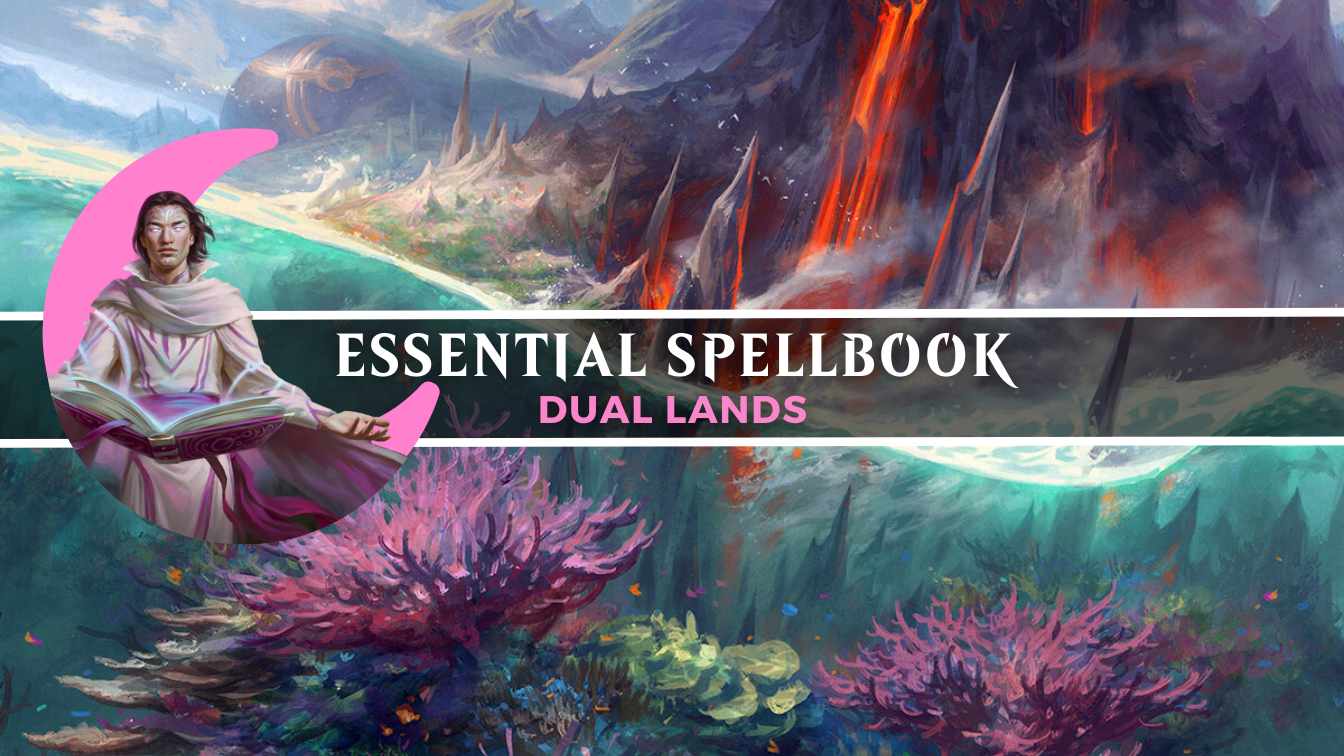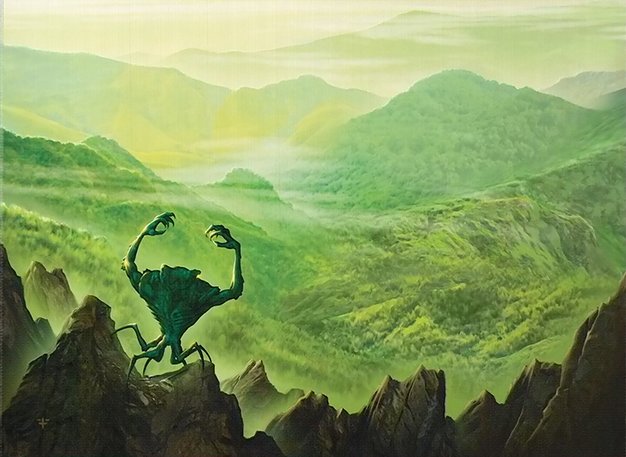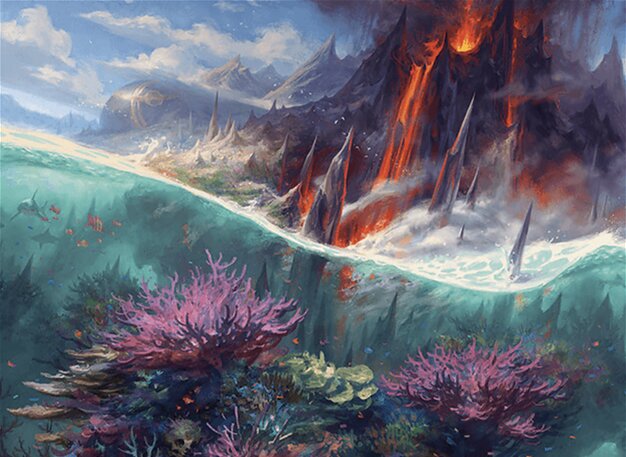Essential Spellbook - Dual Lands

Shivan Reef | Art by Andrew Mar
The Mana You Ordered, On Time, Every Time
Basic lands don't always cut the mustard. If your deck incorporates more than one color of spell, you'll want to include cards that "fix" your mana by producing multiple colors of mana. In my previous article, I discussed some artifacts that produce multiple colors, but by far the most effective way to fix your mana is through the use of dual lands.
These lands produce multiple colors of mana and are an essential part of any deck of two or more colors. Let's dig in!
(Shivan Reef | Art by Andrew Mar)
What Makes a Good Dual Land?
When evaluating lands that fix your mana, there are a few factors to keep in mind:
Does It Enter Untapped?
Some dual lands
Mana Fixing Ability
Or: how reliably does the land produce the colors you need to cast your spells? Most dual lands will always produce two colors of mana, but some
Budget
Magic cards cost money. If you're building a deck on a budget, you may be more interested in the Temples
Usability
Some dual lands
Types
Dual lands that have basic land types
No one land will excel in all of these areas, so it's up to you to determine which are most important to you. Are you working on a budget and looking for cheap fixing, like Foreboding Ruins
It's a tough decision, but I'm here to guide you through the options available.

(Expedition Map | Art by Franz Vohwinkel)
To Map the Multiverse
Let's explore the most essential dual lands in the Commander format. I'll try to provide a comprehensive guide to the lands that can find a home in almost any deck, but I'm going to omit cards that I think are too weak
The Originals
Enters Untapped: 5/5
Fixing: 3/5
Budget: 1/5
Usability: 5/5
Types: Yes
Printed in Magic's first few sets and then never again, these cards are the epitome of what dual lands can be. They offer all of the mana-fixing upside with none of the downside. They also cost, like, four billion dollars.
Over the course of this article, you'll note that the higher a land scores on the "Enters Untapped" metric, the lower it tends to score on the "Budget" metric. The original duals represent one end of this spectrum: incredibly efficient and incredibly pricey.
These cards are absolutely not necessary unless you're playing in an incredibly competitive group. They're better than every other option, but they're only a little better, and they certainly don't make enough of a difference to justify the price tag.
Shocklands
Enters Untapped: 4/5
Fixing: 3/5
Budget: 2/5
Usability: 5/5
Types: Yes
The shocklands are identical to the original dual lands, except that they require a payment of two life in order to enter untapped. Thus, they score slightly lower on Enters Untapped but slightly higher on Budget.
In our forty-life format, two life is often inconsequential, so these lands are usually the best option available at a somewhat reasonable price.
Fetchlands
Enters Untapped: Depends what land you find
Fixing: 5/5
Budget: 2/5
Usability: 2/5
Types: No (thank goodness)
For a payment of one life, a fetchland can find a land with one of two basic land types. This seems straightforward, but note that incredible fixing score. Because fetchlands aren't limited to finding basic lands, in the right deck they can find a land that produces whatever type you want. For instance, Flooded Strand can find you a Plains
These lands are the cornerstone of any optimized mana base in Commander. Because of this flexibility, there's a convincing argument to be made that the fetchlands are even more powerful than the original dual lands.
Fetchlands do take a hit in the usability department, because searching your 100-card library for a specific card can represent an unwelcome pause in an otherwise exciting game.
Because of the way these lands quickly move through the battlefield to your graveyard, they're even stronger in decks that incorporate cards like Rampaging Baloths
Checklands
Enters Untapped: 3/5
Fixing: 3/5
Budget: 4/5
Usability: 5/5
Types: No
The checklands enter untapped if you control a land with one of two associated basic land types. This tends to occur pretty reliably if you build your deck correctly, which means that these cards are an excellent option for players looking to construct a reliable mana base on a budget.
Multiplayer Lands
Enters Untapped: 4/5
Fixing: 3/5
Budget: 3/5
Usability: 5/5
Types: No
Tailored specifically for Commander, these cards will enter the battlefield untapped unless you've already eliminated multiple opponents. Because there's no demand for these cards from 1v1 formats, their price is a lower than other cards that offer the same level of reliability. An absolutely excellent mid-grade option for mana fixing.
Slow Lands
Enters Untapped: 3/5
Fixing: 3/5
Budget: 3/5
Usability: 5/5
Types: No
The slow lands enter the battlefield untapped from the third turn of the game onward. Because Commander games tend to last upwards of seven or eight turns, they're a great option as long as you aren't planning to make critical plays on the first or second turns. Very fast or competitive decks may want to lean away from these cards, but they're fantastic in decks that are oriented towards longer games.
Fast Lands
Enters Untapped: 2/5
Fixing: 3/5
Budget: 4/5
Usability: 5/5
Types: No
In contrast, the fast lands only enter untapped on the first few turns of the game. For the same reasons that the slow lands excel in Commander, the fast lands feel very clunky. They have a home in some aggressive decks, but they're generally a poor fit for our favorite format.
Painlands
Enters Untapped: 5/5
Fixing: 3/5
Budget: 5/5
Usability: 4/5
Considering only the above metrics, the painlands seem like an outlier, scoring high on both the Enters Untapped metric and the Budget metric. However, it's clear where the drawback of these cards lies: each colored mana these cards produce costs 1 life.
Because these lands can produce colorless mana without a life payment, a painland will usually only cost you 2-4 life over the course of the game. This isn't a high cost in Commander, so these lands are a fantastic budget option, but they can become dangerous in multiples.
Reveal Lands
Enters Untapped: 2/5
Fixing: 3/5
Budget: 4/5
Usability: 5/5
Types: No
The reveal lands enter untapped if you reveal certain cards from your hand. In practice, this condition is surprisingly difficult to fulfill, but these lands are dirt-cheap and therefore a decent option for deckbuilders on a budget.
Tango Lands
Enters Untapped: 2/5
Fixing: 3/5
Budget: 5/5
Usability: 5/5
Types: Yes
Because it takes two to tango. Get it?
Another cycle of lands favored by budget-minded players, the Tango Lands enter untapped if you control two or more basic lands. Clever deckbuilders can find uses for these cards, but their utility drops off precipitously in decks with more than two colors.
Currently, only five out of the ten possible tango lands have been printed, so decks in certain color combinations will be left hanging.
Temples
Enters Untapped: 1/5
Fixing: 3/5
Budget: 5/5
Usability: 5/5
Types: No
The Temples are our first lands that always enter tapped. They compensate for this serious drawback by providing a scry 1 effect when they enter the battlefield.
Scrying one card is rarely worth the inefficiency of a tapped land, but this is another wallet-friendly set of lands.
Surveil Lands
Enters Untapped: 1/5
Fixing: 3/5
Budget: 2/5
Usability: 5/5
Types: Yes
The surveil lands resemble the Temples, but with two significant upsides. First, they have basic land types, which means they synergize with other
These cards are currently expensive because they're staple cards in the Standard format. If you're able, I recommend waiting a year or two for a price drop before purchasing them.
Cycling Lands
Enters Untapped: 1/5
Fixing: 3/5
Budget: 5/5
Usability: 5/5
Types: Yes
Another cycle of lands that always enters tapped, the cycling lands can be exchanged for another card if you don't need a land. They also have basic land types! An excellent budget option.
Unfortunately, like the tango lands, the cycling lands are currently only available in five out of the ten potential two-color combinations.
Creature Lands
Enters Untapped: 1/5
Fixing: 3/5
Budget: 5/5
Usability: 4/5
Types: No
The creature lands enter tapped, but can be temporarily animated into creatures for a mana payment. In the average deck, the cost to animate these lands is prohibitive, but they're a budget option comparable to the Temples in terms of utility.
There's also a second cycle of these lands that was recently printed. The second cycle is slightly more expensive at time of writing but offers slightly more utility.
Verge Lands
Enters Untapped: 5/5
Fixing: 2/5
Budget: Currently unknown
Usability: 3/5
Types: No
The brand-new Verges always enter untapped, but sometimes fail to produce a second color. They seem like a a decent option for fixing, but they'll likely have inflated prices due to Standard demand, and it also seems confusing to determine what colors they can make at a glance.
Because they've only recently been printed in Duskmourn: House of Horror, these lands are only available in 5/10 color combinations. Hopefully we'll see the others soon!
Tainted Lands
Enters Untapped: 5/5
Fixing: 2/5
Budget: 5/5
Usability: 4/5
Types: No
The tainted lands only produce colored mana if you control a Swamp
These lands are only available in the color combinations that include black because Torment was a weird set.
Bounce Lands
Enters Untapped: 1/5
Fixing: 3/5
Budget: 5/5
Usability: 3/5
Types: No
The oft-underappreciated bounce lands enter tapped and carry the enormous drawback of returning a land you control to your hand. However, they also produce two freaking mana.
In practice, this means that these cards play like lands that enter tapped but draw you a land card when they do. That's a fantastic upside, but it's somewhat tempered by the fact that the bounce lands can be a bit awkward in the first couple turns of the game. You can't play a bounce land on your first turn at all, or else it'll return itself to your hand!
Even so, these lands are fantastic in small quantities, and they only grow in value when paired with cards that allow you to play extra lands
Filter Lands
Enters Untapped: 5/5
Fixing: 3/5
Budget: Varies wildly
Usability: 4/5
Types: No
The filter lands can turn mana of one color into mana of another color, and they're both better and worse at mana fixing than more traditional dual lands. Consider the following situations:
You have a Mountain
You have a Mountain
In general, I recommend playing these cards in decks with fewer colors, or in decks that really want lots of one specific color of mana.
Signet Lands
Enters Untapped: 4/5
Fixing: 2/5
Budget: 5/5
Usability: 3/5
Types: No
The signet lands (named after the Ravnica signets
Also, if you have a bunch of filter lands and signet lands in play, determining what mana you can make becomes a terrible math problem.
Pathways
Enters Untapped: 5/5
Fixing: 2/5
Budget: 4/5
Usability: 3/5
Types: No
When you play a Pathway, you choose which color of mana it will permanently produce. Since they'll never be able to produce two colors at once, they're not as good at fixing your mana as some other options, so I'd avoid them in decks with four or more colors. However, they enter untapped with no life payment, which makes them strong contenders to replace a couple basics in your favorite deck.
It's a bit annoying to take them out of their sleeves and flip them around, though.

(Explore | Art by Franz Vohwinkel)
I Challenge You to a Dual
What do you think of my assessments? Did I score something improperly? Forget an essential cycle of lands? Let me know!
Want lands that score higher than a 3/5 for Fixing? Join me next week as I discuss lands that produce more than two colors of mana!
Please note: card prices listed in this article are accurate at the time of writing, but prices can vary over time and between locations.
